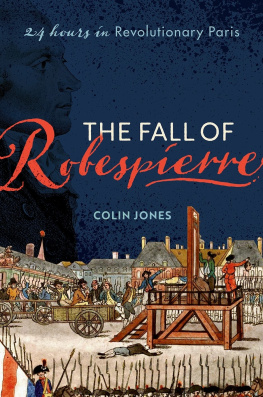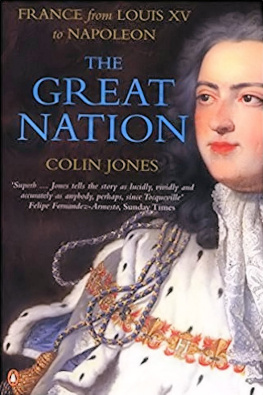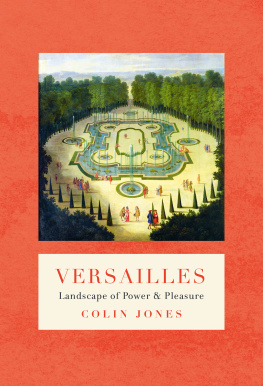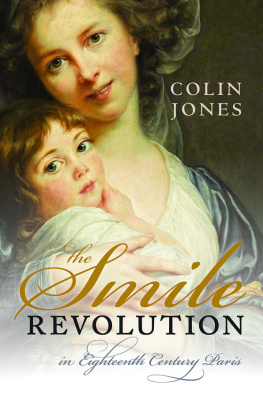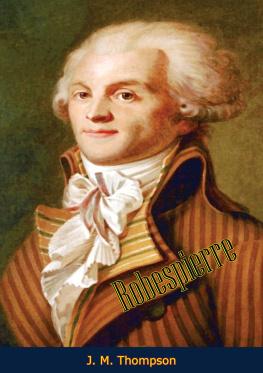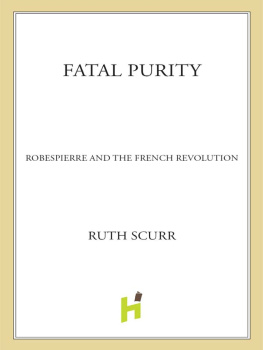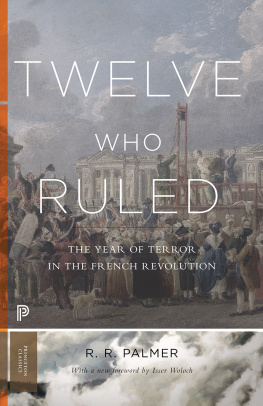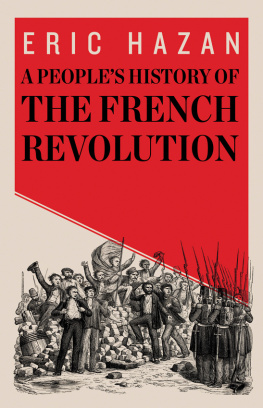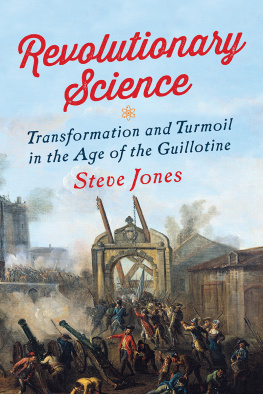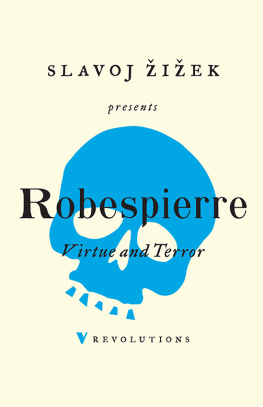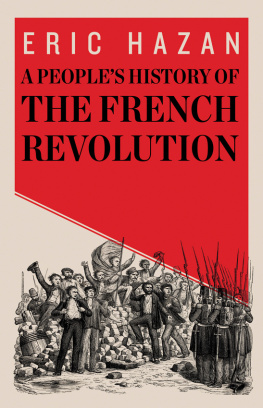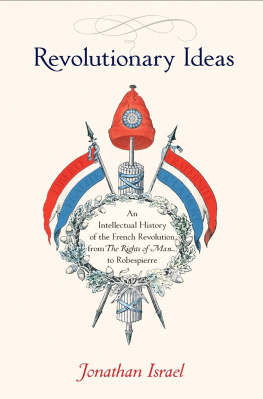The Fall of RobespieRRe

Great Clarendon Street, Oxford, ox 2 6 dp , United Kingdom
Oxford University Press is a department of the University of Oxford. It furthers the Universitys objective of excellence in research, scholarship, and education by publishing worldwide. Oxford is a registered trade mark of Oxford University Press in the UK and in certain other countries
Colin Jones 2021
The moral rights of the author have been asserted
First Edition published in 2021
Impression: 1
All rights reserved. No part of this publication may be reproduced, stored in a retrieval system, or transmitted, in any form or by any means, without the prior permission in writing of Oxford University Press, or as expressly permitted by law, by licence or under terms agreed with the appropriate reprographics rights organization. Enquiries concerning reproduction outside the scope of the above should be sent to the Rights Department, Oxford University Press, at the address above
You must not circulate this work in any other form and you must impose this same condition on any acquirer
Published in the United States of America by Oxford University Press
198 Madison Avenue, New York, NY 10016, United States of America
British Library Cataloguing in Publication Data
Data available
Library of Congress Control Number: 2021935694
ISBN 9780198715955
ebook ISBN 9780191025044
Printed and bound in Great Britain by
Clays Ltd, Elcograf S.p.A.
Links to third party websites are provided by Oxford in good faith and for information only. Oxford disclaims any responsibility for the materials contained in any third party website referenced in this work.
For Jo
It wasnt about principles;
it was about killing
Marc-Antoine Baudot,
on the overthrow of Robespierre
Acknowledgements
This is a book about Paris and in writing it, I have derived continuous inspiration from the work of two very great and very different historians of the city and its people in the eighteenth century, namely, Daniel Roche and the late Richard Cobb, to whom I would like here to pay homage. I have also taken infinite pleasure from the fact that while researching and writing, I have had Louis-Sbastien Merciers Tableau de Paris and Le Nouveau Paris at my elbow and Hilary Mantels A Place of Greater Safety in the back of my mind.
I originally chose to tell the story of 9 Thermidor in the Mercier way described in the Introductionup close, in detail, and with an eye to time, space, and sequenceout of a sense of curiosity and fun. As historians, we always write under the constraints imposed by our evidence, but I felt it would be interesting to add a further level of complexity and challenge. I found myself attracted less to the work of other historians than to experimental authors I like such as George Perec, whose 1969 novel, La Disparition is written without recourse to the letter e, and Raymond Queneau, whose 1947 Exercices de style recounts a mundane incident on a Parisian bus from 99 different angles and in 99 different styles. The two men belonged to the Oulipo tradition of writing under constraint. What I learned from my own, lesser challenge in constraintwriting hourly chapters and compressing the narrative within a single daywas that it provokes and stimulates the imagination in unexpectedly rewarding and pertinent ways. In my case, it directed my thinking afresh to issues of place, time, timing and story-telling that proved to lie at the heart of the argument of this book. The result, I hope, is not just an exercise in style but an enhanced pathway towards understanding a key historical event.
The idea for the book followed on from conversations with my wonderful agent, the late Felicity Bryan, whose death came towards the end of the writing stage. I was privileged to have benefited from her unmatchable vitality, energy, and invigorating enthusiasm for nearly 30 years. I thank Catherine Clarke of the Felicity Bryan Agency for her help in the completion stages. At OUP, Luciana OFlaherty and her team have guided me calmly through everything.
In the years spent researching and writing the book, I have learnt so much from the many friends who have patiently listened to me talking about it in conferences, seminars, over coffee or drinks, and around dinner tables, and have offered interest, critical insights, and moral support. I cant name them all: but I hope they know who they are and that they realize the depth of my gratitude. Among the many, I would like to thank the following for particular assistance with the project in some material or intellectual way: Stephen Clay, Laurent Cuvelier, Vincent Denis, Robert Darnton, Ariane Fichtl, Mette Harder, Martyn Lyons (a long time ago!), Jonathan Sachs, Steve Sawyer, Pierre Serna, Anne Simonin, and Charles Walton. I am also exceptionally lucky to have had as readers of an earlier draft of my manuscript David Bell, Alex Fairfax-Cholmeley, David Jordan, Simon Macdonald, and Michael Sonenscher. I could not have been in better hands. Salut et fraternit for their time, their kindness, and their friendship. Simon has also been a source of endless encouragement and the communicator of a large number of archival finds. I should stress that all errors remaining are strictly my own achievement. I also thank Natalie Smith for research and bibliographical assistance and Miles Irving who drew the maps. Dominique Lussier was an excellent indexer.
I was supremely fortunate to have been awarded a Major Research Fellowship from the Leverhulme Trust, which I acknowledge with enormous gratitude. The Trusts generosity in funding what it esteems as valuable and cutting-edge research makes it a jewel in the British research landscape. I was able to work on the project in a number of locations, where I delivered papers on the topic. These include University of Richmond, Virginia where I held the Freeman Professorship (2013); the National Humanities Center, North Carolina (2014) where I was Carl and Lily Pforzheimer Fellow; and the University of Chicago, where I have been Visiting Professor since 2018. Thanks are due to the Universitys Modern France Workshop for interest and encouragement. I oversaw the production process while Fellow at the Institut dtudes avances in Paris for 202021a pleasure that even COVID-19 failed to spoil (though it tried hard). I wish also as ever to thank my colleagues in the School of History, Queen Mary University of London, especially Julian Jackson, Miri Rubin, and Quentin Skinner, for the gift of their friendship and support.
I cant list all the venues where I have delivered papers and talks, but would mention the honour bestowed in being asked to give plenary lectures which helped me crystallize my ideas. These include the Oxford University Faculty of History lecture, 2011; the University of Richmond Douglas Southall Freeman lecture, 2013; the Social History Society plenary lecture, 2014; and the Voltaire Foundation Besterman lecture, 2015.
The book has been developed over the years and some outputs overlap with the finished manuscript, notably The Overthrow of Maximilien Robespierre and the Indifference of the People, American Historical Review, 119 (2014), pp. 688713; 9 Thermidor, Cinderella of French Revolutionary Journes, French Historical Studies, 38 (2015), pp. 931; Robespierres Fall, History Today, 65 (August 2015), pp. 3944; Robespierre, the Duke of York and Pisistratus during the French Revolutionary Terror,

